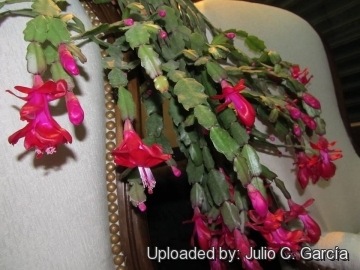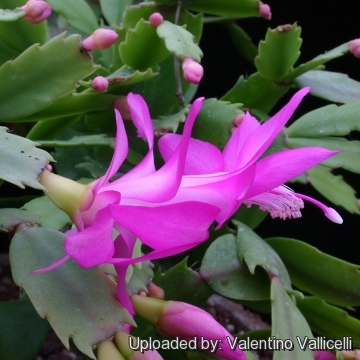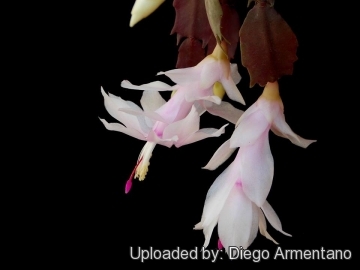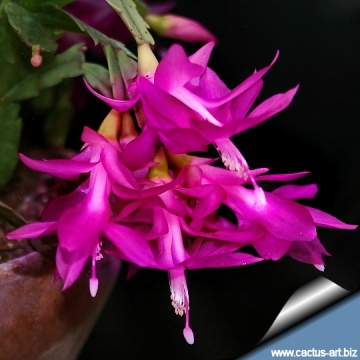Accepted Scientific Name: Schlumbergera truncata (Haw.) R.Moran
Gentes Herb. 8: 329. 1953

Cactus truncatus (Schlumbergera truncata) Photo by: Valentino Vallicelli
It is a soft stemmed & spineless cactus which blooms very profusely.
Origin and Habitat: Brazil, Rio de Janeiro (Serra do Mar and Serra dos Orgãos). Schlumbergera truncataSN|2948]]SN|2948]] has a restricted range (extent of occurrence about 7,000 km2) and is known from about ten locations.
Altitude range: From near sea level to about 1500 metres above sea level.
Habitat & ecology: Schlumbergera truncataSN|2948]]SN|2948]] is an epiphytic, sometimes lithophytic plant native to the coastal forests and jungles. In other words, these are cacti that grow in trees (or on granite, gneiss inselbergs) in Atlantic forest. They grow their roots into the bark of their host tree. Their only access to moisture and nutrients is from rain and droppings that fall from above. They also always grow under a canopy of trees and are never exposed to the full sun of the desert. The environment that these cacti have adapted to is that of the warm, humid jungle with sunlight filtered through the canopy of the forest. The shape of the flowers suggests humming bird pollination and red is attractive to birds. The berry is mostly red attracting other birds to spread the seed to other areas. This species is locally common, but the sites are severely fragmented, and there is continuing decline in mature individuals due to illegal collection and other human activities (all known sites are close to urban areas).
Synonyms:
See all synonyms of Schlumbergera truncata
back
Accepted name in llifle Database:Schlumbergera truncata (Haw.) R.MoranGentes Herb. 8: 329. 1953Synonymy: 16
back
Common Names include:
ENGLISH: False Christmas Cactus, Thanksgiving Cactus, Crab Cactus, Zygocactus, Lobster cactus, Claw Cactus, Holiday Cactus, Linkleaf, Yoke Cactus, crab's claw cactus, Easter Cactus
CHINESE (中文): 蟹爪, 蟹爪兰属
CZECH (Čeština): Vánoční kaktus
DANISH (Dansk): Helligdagskaktus
DUTCH (Nederlands): Lidcactus
FRENCH (Français): Cactus de Noël
GERMAN (Deutsch): Weihnachtskakteen
HEBREW (עברית): שלומבערגערא
HUNGARIAN (Magyar): karácsonyi kaktuszok
ITALIAN (Italiano): Cactus di Pasqua
JAPANESE (日本語): シャコバサボテン
NORWEGIAN (Nynorsk): Heilagdagkaktus
POLISH ( Polski): Szlumbergera, Kaktus bożonarodzeniowy, Grudnik, Zygokaktus
RUSSIAN (Русский): Шлюмбергера, Шлюмбергера трунката
SPANISH (Español): Cactus de Navidad
SWEDISH (Svenska): Julkaktussläktet
UKRAINIAN (Українська): Шлюмбергера
Description: Christmas cactus Schlumbergera truncataSN|2948]]SN|2948]] is a much branched cascading epiphyte, also knows as crab's claw cactus up to 30 cm tall before weeping and 30-45 cm in diameter. The individual flattened, spineless joints of these popular cacti form arching, pendulous branches from whose tips hang satiny, zygomorphic flowers that ranges in colour from red to pink, purple, orange, white or multicolour, with yellow pollen, white filaments, and terete ovaries.
Stem segments (phylloclades): Truncate, 4-6 cm long, 1.5-3.5 cm broad, flattened leaf-like dark and glossy dark green with two teeth at the apex and small 2-3 toothed (pointed), marginal notches on each side.
Areoles: Almost spineless or with tiny brush-like spines and little felt. Terminal areole between two teeth composite, long and felty.
Flower: Zygomorphic (bilaterally symmetrical), borne slightly above the horizontal both at the stem joints as well as at the stem ends, hooded, tubular 6.5-8(-12) cm long, 4.5-6 cm wide, red, pink, purple, orange, white or multicolored. Style purple. Pericarpel round, smooth, reddish green. Receptacle 4 cm long. Stamens in two groups, filaments white, pollen yellow. Little has been written of the variability of colour in the flower in the wild although one would assume that red predominates.
Blooming Period: Autumn and winter ( In northern hemishere November through February). Flowering is triggered by short days and cool temperatures
Fruit: Round to pear shaped, red, smooth.
Notes: Zygocactus hybrids (Christmas cactus):
These hybrids, often cultivated as a houseplant, with their rather unique flower arrangement, have been in cultivation since early in the 1800s and have had surges of popularity. The term Zygocactus is the name predominant in the plant industry despite what the taxonomists have decreed are now Schlumbergera. There are many garden varieties, most of which are very beautiful. The greenhouse cultivars has salmon, orange, peach, coral, yellow, white pink or multicoloured flowers.
Bibliography: Major references and further lectures
1) James Cullen, Sabina G. Knees, H. Suzanne Cubey “The European Garden Flora Flowering Plants: A Manual for the Identification of Plants Cultivated in Europe, Both Out-of-Doors and Under Glass” Cambridge University Press, 11/Aug./2011
2) David Hunt, Nigel Taylor “The New Cactus Lexicon” DH Books, 2006
3) Edward F. Anderson “The Cactus Family” Timber Press, 2001
4) Neil O. Anderson “Flower Breeding and Genetics: Issues, Challenges and Opportunities for the 21st Century” Springer Science & Business Media, 01 October 2007
5) Hecht. BI.V Handbuch der Kakteen, 215 1982
6) Taylor, N.P. & Zappi, D. 2013. Schlumbergera truncata. The IUCN Red List of Threatened Species 2013: e.T152554A650443. . Downloaded on 26 February 2016.
7) Hunt, D.R. "Contributions to the Flora of Tropical America: LXXVII: A Synopsis of Schlumbergera Lem. (Cactaceae)", Kew Bulletin 23 (2): 255–263 1969
8) A. J. S. McMillan, John F. Horobin "Christmas Cacti: Genus Schlumbergera and Its Hybrids." Royal Botanic Gardens of Kew 1995
 Cactus truncatus (Schlumbergera truncata) Photo by: Julio C. García
Cactus truncatus (Schlumbergera truncata) Photo by: Julio C. García Cactus truncatus (Schlumbergera truncata) Photo by: Valentino Vallicelli
Cactus truncatus (Schlumbergera truncata) Photo by: Valentino Vallicelli Cactus truncatus (Schlumbergera truncata) Photo by: Diego Armentano
Cactus truncatus (Schlumbergera truncata) Photo by: Diego Armentano Cactus truncatus (Schlumbergera truncata) Photo by: Cactus Art
Cactus truncatus (Schlumbergera truncata) Photo by: Cactus Art Cactus truncatus (Schlumbergera truncata) Photo by: Cactus Art
Cactus truncatus (Schlumbergera truncata) Photo by: Cactus ArtSend a photo of this plant.The gallery now contains thousands of pictures, however it is possible to do even more. We are, of course, seeking photos of species not yet shown in the gallery but not only that, we are also looking for better pictures than those already present.
Read More... Cultivation and Propagation: Like the Poinsettia (Euphorbia pulcherrima), it takes very little effort to get your Christmas cactus to flower at the right time. It requires ample summer water and partial shade, but allow soil to dry slightly between waterings; The Christmas cactus is a short day bloomer. Remember that the shortening days of September and October are what trigger the flowering cycle. Allow also temperatures at night to drop slightly to induce flowering. During the flowering cycle, keep your Christmas cactus moist (but not soggy). After the blossoms have fallen off you should back off on the water for a couple of months. If it needs repotting, this is the time to do it. Christmas cacti won't want a normal cactus soil but will prefer to be in a soil containing sphagnum. This type of soil would normally be used for orchids, bromeliads or other epiphytic plants. The Shlumbergera drop their buds easily if they are moved. Once flower buds have formed, DO NOT MOVE the plant, as slight changes in environment may cause the buds to drop. These forest cacti tend to be long lived.
Propagation: Stem cuttings, Grafting (For grafting this plant Acanthocereus pentagonusSN|4326]]SN|4326]] is a good stock)















